Howdy-ho, Bubblenauts, and welcome to our fourth foray into the DC Timestream. In case you missed out on the previous trips, we stopped in at the first week of March, 1952, for the first official Superman/Batman team-up, the second week of March in 1977, to witness the introductory adventure of Shade, the Changing Man, and the third week of March, 1997, when Superman underwent his electrifying change.
Now, for the fourth week in March, we travel back 50 years for the first performance of DC’s own Fab Four — The Maniaks!
The who — you ask?!
As you probably know, Showcase was DC’s tryout book, famous for launching the Silver Age reboots of The Flash, Green Lantern, and The Atom, as well as debuting such other famous features as the Challengers of the Unknown, Adam Strange, and The Metal Men. But by mid-run the series hit something of a creative slump, with the best it could muster being B’wana Beast. And that’s where the Maniaks came in.
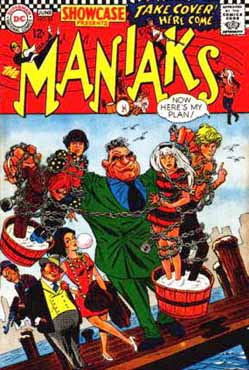 SHOWCASE #68
SHOWCASE #68
(on-sale Thursday, March 23)
Created by E. Nelson Bridwell, with art by Mike Sekowsky, the rock group plugged in just six months after The Monkees made their television debut (on Sept. 12, 1966). The Monkees, of course, made America safe for long-haired rockers and, I think it’s safe to say, The Maniaks was comics’ first attempt to cash in on that success. Even the Teen Titans, who appeared in Showcase #59 before being spun off into their own mag, were only on their 9th issue at this point, and only just starting to spout the daddy-O hippie-speak for which they would become famously reviled.
Bridwell, one of the first fans-turned-pro, had done several quality parodies at MAD Magazine, so he would’ve seemed a natural for this assignment. But while he was still new to DC at this point, just a couple of years on the job, he was also 36 years old, and more than a little strait-laced — the kind of obsessive proto-geek who created the Kryptonese alphabet and became famous as DC’s “continuity cop.” At any rate, he was at least a full generation removed from the counter-culture The Maniaks purports to inhabit. Still, Bridwell was probably about, if not the youngest person roaming the halls of the DC offices at this point, so, I suppose it made sense from editor Jack Miller’s standpoint to stick him on this assignment. Miller, by the way, was a former writer put in charge of DC’s romance books. Industry rumor — and I stress this is just rumor, I have no way of knowing, myself — is that Miller took kickbacks from artists and was fired from DC for stealing art. The latter rumor seems far-fetched to me, as original artwork was not highly valued in this era, and a lot of folks walked off with pages, and that’s when DC wasn’t actively involved in literally throwing the stuff out itself. Miller’s not around to argue the point, though. He reportedly died in 1970.
Anyway, the only issues of Showcase Miller edited were the ones featuring the Maniaks or the Inferior Five, also created by Bridwell. Miller probably is the root cause of DC’s brief foray into Monkee-mania, of a sorts. After all, Bridwell has said that while he invented the Inferior Five, he was given marching orders by Miller to come up with a set of incompetent super-heroes. Miller originally called the group The Inferior Four until Bridwell delivered a team with five members. I imagine it was Miller who said to Bridwell, “Okay, this month, give me crime-solving rock band, just like the Monkees, only different. Just make sure it’s ‘groovy,’ and ‘far out,’ and all those other things the kids are in to.” So, it’s not too surprising that this comic book rock band, try as in might, falls far short of the madcap hi-jinks of their faux-band inspiration.
Bridwell had created the Inferior Five just a few issues earlier, and like that team, the Maniaks are all one-note personalities built around a single shtick. The band includes Gilbert “Jangles” Jeffries on guitar. He’s a perfect mimic with his voice, able to perform ventriloquism stunts and various sound effects. Oddly, given this talent, he’s not the singer. That honor goes to platinum-haired Silver Shannon, a.k.a. “the mod miser,” whose greatest ambition was not to become rich and famous by hitting the top of the pops, but to find herself a sugar daddy and retire to a life of leisure. The drummer is Byron “Rat Pack” Williams, who not only collects junk, but beat MacGyver to the whole MacGyver thing by about 20 years. Finally, the bassist is Philip “Flip” Folger, who is also, of all things, an acrobat and contortionist.
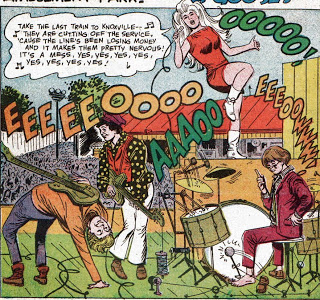 Using these additional talents — or, in Silver’s case, the lack thereof — the Maniaks basically become a kind of inadvertent crime-fighting troupe. In their first issue, they’re performing at New Jersey’s Palisades Park — which advertised in DC Comics throughout most of the Silver Age of comics — with the set including a parody of “Last Train to Clarksville” called, “Last Train to Knoxville,” just to make it clear where the band, and Bridwell, was mining for musical inspiration. After the show, while fleeing a mob of crazed fans, the bandmates happen upon a gang hit ordered by mobster “Eggs” Benedict. Witnesses to the crime, the band members each employ their singular non-musical abilities to evade capture. But finally corralled and fitted for cement shoes, Silver saves the day by singing a song so sad it reduces the wiseguys to tears, allowing the boys to flip, mimic, and gadget-ize their way to freedom.
Using these additional talents — or, in Silver’s case, the lack thereof — the Maniaks basically become a kind of inadvertent crime-fighting troupe. In their first issue, they’re performing at New Jersey’s Palisades Park — which advertised in DC Comics throughout most of the Silver Age of comics — with the set including a parody of “Last Train to Clarksville” called, “Last Train to Knoxville,” just to make it clear where the band, and Bridwell, was mining for musical inspiration. After the show, while fleeing a mob of crazed fans, the bandmates happen upon a gang hit ordered by mobster “Eggs” Benedict. Witnesses to the crime, the band members each employ their singular non-musical abilities to evade capture. But finally corralled and fitted for cement shoes, Silver saves the day by singing a song so sad it reduces the wiseguys to tears, allowing the boys to flip, mimic, and gadget-ize their way to freedom.
The Maniaks would play another set in Showcase #69, then, after an intermission for an issue of inexplicable Binky reprints from 1956, the group would then play an encore in Showcase #71, an issue famous for guest-starring Woody Allen, as the gang helped him with his Broadway musical about the Civil War. Yeah, I know, I can only assume Bridwell was ordered to include Allen and didn’t know who he actually was. Funny thing, Silver would for defs have sunk her hooks into Woody, but he had no interest, she being too age-appropriate for him at the time.
After that, the Maniaks graduated from Showcase into their own series and became the darlings of the Bronze Age, right? Wrong-a-ding-dong, hep cat! Despite begging readers to support their cause, The Maniaks were never heard from again. And how big an embarrassment were they to DC? Well, Showcase got canceled at Issue #93 (on-sale July 28, 1970). The title would get revived in 1977 as part of the “DC Explosion,” and the landmark 100th issue would feature almost every character to grace the first 99 issues. But who do you think went without an invite to that particular party? Yup. The Maniaks.
But that’s not the end of the story, because, in comics, no one ever stays dead — figuratively or literally.
Silver would reappear in the 2002 series The Power Company, as personal assistant to company founder Josiah Power. And just this past month, in Justice League of America: Vixen: Rebirth, super-model Vixen is said to be dating Phil Folger, referenced as a member of The Maniaks. So, it may be safe to assume he, and maybe the whole band, will soon see some panel time. Heck, it might even happen that, 50 years after first laying out the beg, The Maniaks will finally get that series they wanted so badly.
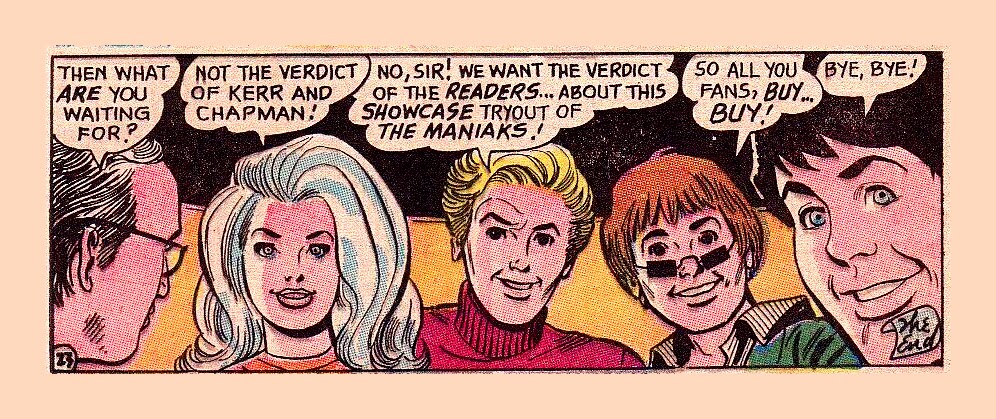
So, what else did DC have out on the stands during the fourth week of March, 1967? As it turns out, not much. the company only released 28 titles that entire month — and three of them were romance titles!
Here’s what was out the same week as Showcase #68:
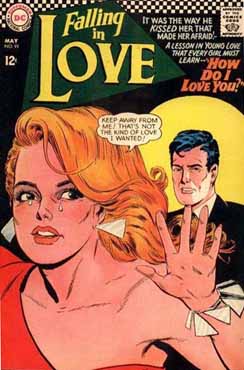 FALLING IN LOVE #91
FALLING IN LOVE #91
(on-sale Tuesday, March 21)
Marvel is famous for chasing every fad to come along during the 1950s, but DC was not one to let potential sales slip away just because someone came up with an idea first. So, it, too, jumped on the romance bandwagon. When Falling in Love came along on July 7, 1955, it was already 34 issues deep into Girls’ Romances, 29 issues into Secret Hearts, and 37 issues into Girls Love.
However, you wouldn’t necessarily know those were DC Comics, as there was no indication of a relationship anyway on the cover. In fact, Falling in Love didn’t get a company brand until its 10th issue, and then it was what appeared to be a DC Bullet, but with a red heart at the center of the circle in place of the “DC” and the words “National Romance Group” standing in for the usual “Superman National Comics.” The traditional DC Bullet would not grace a FIL cover until #50 (on-sale Feb. 6, 1962). The series would last all the way to #143, out on July 3, 1973.
At the time of this outing, Ann Margaret was still a hot commodity, and so it doesn’t surprise me that the honey on this Jack Sparling cover is a dead ringer or the dahlia-haired debutante. And that cover copy! “It was the way he kissed her that made her afraid!” Indeed. Of course, comic book fandom is filled with devotees of the super-hero, who generally balked at this kind of thing then, as they do now. There are four stories in this issue and the Grand Comics Database has yet to identify a writer for any of them. So, there’s still a great deal of scholarship to be done on this genre.
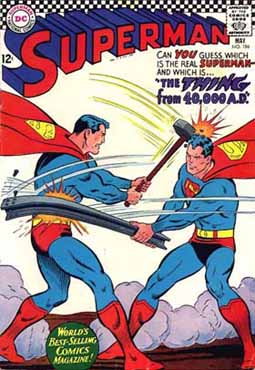 SUPERMAN #196
SUPERMAN #196
(on-sale Tuesday, March 21)
Hey, look out, Logan! Superman is battling his own S-24!!
Actually, it’s “The Thing from 40,000 A.D.” and it’s actually a reprint of a 1954 Bill Finger story from Superman #87. Also, it’s a grammatical grotesque. Word geeks know the date would properly be A.D. 40,000.
It was not at all unusual for editor Mort Weisinger to recycle old plots — allegedly swiping them from old Superman comics and passing them off to writers as his plot ideas. So, to actually reprint one, he must’ve been way behind schedule this month.
The Thing, a protoplasmic blob that really only wanted to go home, would appear again for reals, though. Nearly two decades after this reprint, and 30 years after his first appearance (on Oct. 3, 1985, to be precise), he’d turn up as the Big Bad in the Superman/Omega Men team-up in DC Comics Presents #89.
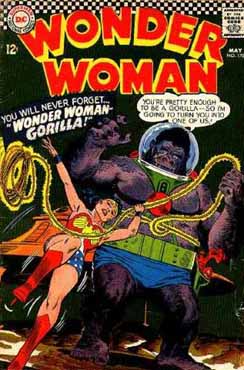 WONDER WOMAN #170
WONDER WOMAN #170
(on-sale Tuesday, March 21)
The legend, which may actually be true, for all I know, is that the only reason DC continued to publish Wonder Woman through the ’50s and ’60s is that it had to. Otherwise, if she went unpublished for a certain length of time — the exact stretch of which tends to change depending on who’s telling the story — all rights would revert to her creator, Willie Fetish Manslave.
Personally, I tend to believe it. I mean, Wonder Woman comics of this period were the worst. Just, The Worst. I can’t imagine who was buying them. Take this issue as an example. Now, Robert Kanigher told some pretty good war yarns, and let’s don’t forget, he gave us Barry Allen, but the Wonder Woman stuff? Eeeeicch. In, “Wonder Woman — Gorilla,” drawn by Ross Andru and Mike Esposito, a trio of alien gorillas (because aliens would evolve to look just like terran gorillas, naturally) land on Paradise Island, which was still just Paradise Island, and not yet Themyscira. Wonder Woman intercepts to shoo them off, concerned that their presence will break the island’s man-begone rule. Apparently, it’s not just human men who are not to set foot on Paradise Island, but male animals of any variety, whether from this planet or not. Well, the king gorilla gets all warm for Wondy’s form and decides he wants to marry her, so, of course, he turns her into a gorilla. Yes, you read that right. But, oh, noes! It turns out that, as a female gorilla, Wonder Woman is kind of an ugg.
So, Wonder Woman is all, like, hey, if you think I’m hotter as a human, why not turn me back. Then make yourself human, too, and we can really go ape on each other. This makes sense to Mr. Space-Monkey, so he does it, which allows Wonder Woman to use her magic lasso to order him and his gorilla pals to leave Earth forever.
This is off, of course, because, for some reason, the gorillas are human enough to trip Paradise Island’s no-man rule, but not enough for the magic lasso to work on them. And I thought the lasso only compelled those within its snare to tell the truth. But, I guess when you’ve got a nine-page plot to wrap up fast, it can do all kinds of things.
The other story in this issue, a 14-pager by the same creative team, titled “The Haunted Amazon,” is some foolishness in which Dr. Psycho, plastic surgeon extraordinaire, makes a crook look like Steve Trevor, who is presumed to have died in a plane crash, and poor Wonder Woman can’t bring herself to haul the bad guy in, being reduced to a puddle of female frailty because he looks so much like her dead boyfriend.
 GIRLS’ LOVE STORES #127
GIRLS’ LOVE STORES #127
(on-sale Tuesday, March 23)
Hey, look! Ann Margaret is back!! This time on a cover by Jay Scott Pike. Or maybe it’s by Jack Sparling. Sources differ. It would seem off for Sparling to turn in two covers in the same month with essentially the same generic lovelorn, though. At any rate, the cover story, “He Couldn’t Be True to Me,” is drawn inside by Manny Stallman, and written by Kanigher, of all people. The story, one of three in this issue, was reprinted with a new script in a 2001 tpb from Watson-Guptill Publications, titled “Truer Than True Romance: Classic Love Comics Retold.” For a while there, there was kind of a fad for re-scripting cheesy old romance comics with new, even cheesier dialogue.
Girls’ Love, which had it’s coming-out party on June 17, 1949, was DC’s first romance comic. Or first, at least, if we don’t count the short-lived western-hybrid, Romance Trail, which mosied in the previous month. The first nine issues of Girl’s Love sported photo covers. Whether they were stock pictures, or actually posed by editors at DC, I don’t know, although I suspect the former. The title would last all the way to #180, dying on August 21, 1973, in the same purge that claimed DC’s entire romance line.
That may have been a lost opportunity for DC. For a brief time in the early ’70s, DC experimented with a thing called the “comicmobile.” It was basically like an ice cream truck, driven around to playgrounds and other places where kids congregated. I seem to recall in interview with Bob Rozakis, who piloted the rig, that at least one of the romance comics was one of his better sellers from that venue.
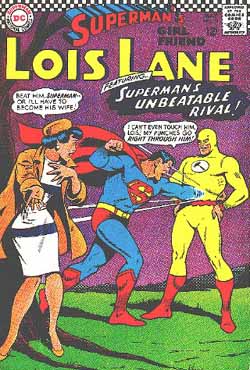 SUPEMAN’S GIRLFRIEND, LOIS LANE #74
SUPEMAN’S GIRLFRIEND, LOIS LANE #74
(on-sale Tuesday, March 23)
Sigh. It wasn’t just Wonder Woman comics if the late Silver Age which blew chunks. Lois Lane’s book was no literary thrill, either. Take this issue for example, and, “Superman’s Unbeatable Rival,” by Leo Dorfman and Kurt Schaffenberger. When a spaceman crash lands on Earth, Lois revives him with a kiss, whereupon he takes the heroic identity “Hero,” and performs super-feats, causing Lois to get all misty and think the kiss might have been the start of something. But jealous Superman shows up and reveals Hero to be, in actuality, the Flash of Bizarro-World! Talk about WTF twists!
The second story in this issue, also drawn by Schaffenberger, sees Lois cutting herself on an arrow in the Robin Hood museum and, because, just like Gilligan, Lois always dreams about whatever she was thinking when she gets knocked out, she imagines herself back in Crusading Times trying to romance original Merry Man, who, in this tale, happens to hold down a day job as . . . a chimney sweep?? Again, WTF?!
So long as we started this column talking about Showcase, it’s worth noting that Lois was actually the first feature to graduate from that book into her own title. After headlining Showcase #9 (May 16, 1957) and #10 (July 16, 1957), Lois got her own mag, with #1 hitting stands Jan. 14, 1958.
The interesting thing (to me) about this issue is that, while DC was trying to be all hip and mod with the Maniaks, Lois was here still sporting her Jackie-O hairdo and pillbox hat, with a dress straight out of the Sears catalog. But that was about to change. She was growing her hair out by the very next issue, and just six issues hence, in #80 (on-sale Nov. 6, 1967) Lois was on the cover sporting go-go boots and a mini skirt. So, in many ways, this issue can be thought of as the last true Silver Age Lois story.
Lois’ book would last until #136 (on-sale Oct 11, 1973) when her title, with get merged with those of Jimmy Olsen and Supergirl to form Superman Family, which hit stands on Jan. 24, 1974, picking up the numbering at from Jimmy’s book at $164. Oddly, and for reasons I’ve never understood, Lois would get one more issue after the merger. Issue #137 or her title had a June 27, 1974 release date.
Okay, now, given the relative dearth of comics DC put out this month, and given that it may be a while before the bubble pops this way again, let me just go ahead and give you a quick rundown of everything else the company put out in March 1967. Because, as 50th anniversaries go, there are a few milestones worth mentioning . . .
— on-sale Thursday, March 2 —
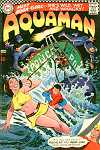 AQUAMAN #33
AQUAMAN #33
It’s the first appearance of Tula (a.k.a. Aquagirl in “Aqualad’s Deep-Six Chick,” by Bob Haney and Nick Cardy. These days, Tula is head of the Atlantean military, so I guess we can say she’s done okay for herself. As a kid, I always thought Aquagirl had a lot of missed potential. But then, Aqualad himself wasn’t getting much panel time in the mid-’70s. Also, getting few further appearances (i.e. none) was the villain of this issue, Doctor Dorsal.
 OUR ARMY AT WAR #180
OUR ARMY AT WAR #180
Kanigher is more at home here than on Wonder Woman, chronicling Sgt. Rock in, “You Can’t Kill a General,” alongside legendary artist Russ Heath. Meanwhile, the backup tale, “Frogman Roulette,” is a rare full-art outing for Jack Abel, better known as a Superman inker during the ’70s and ’80s. Our Army had been in service since June 13, 1952, with Sgt. Rock commandeering the title since #158 (July 1, 1965) when his name began eclipsing the book’s actual name on the covers. It’d become official with #302 (Dec. 2, 1976), and as Sgt. Rock the title would last until #422, called a truce on March 22, 1988 (29 years ago this month).
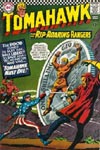 TOMAHAWK #110
TOMAHAWK #110
In its early days, when this title took the Colonial era seriously, and sported lush artwork by Fred Ray, Bruno Premiani, and occasionally Frank Frazetta, this was one of the nicest books on the stands. But by this period it had gotten a little silly in trying to keep up with trends, giving Tomahawk a team of Rangers and pitting them against giant gorillas and dinosaurs and super-villains. The heroine on the cover is Miss Liberty, who was a semi-regular supporting player in the series starting with her first appearance in Issue #81 (May 3, 1962). Tomahawk would attempt a more serious turn starting with #131 (Sept. 1, 1970) when it would become, on the covers, at least, Son of Tomahawk, transporting the adventures from Colonial/Revolutionary times, into the Old West. It didn’t seem to help though, and another was was over at #140 (March 9, 1972), 45 years ago this month.
— on-sale Tuesday, March 7 —
 BATMAN #191
BATMAN #191
Oh, the camp period of the Batman TV show, as exemplified on this cover — look (gasp), REAL tears! “The Day Batman Sold Out,” by writer John Broome and the art team of Sheldon Moldoff and Joe Giella, has the villain Radon subjecting Batman’s equipment to radiation, which leeches into Batman and forces him to retire and auction off his wonderful toys. But, wait, wouldn’t the radiation also affect the buyers? No matter, Bruce Wayne bought it all. The backup tale is a solo Alfred outing, “Alfred’s Mystery Menu,” by the same art team, but with Gardner Fox at the typewriter.
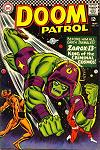 DOOM PATROL #111
DOOM PATROL #111
Two tales in this issue, both by team creators Arnold Drake and Premiani, with the second, “Neg Man’s Last Road,” a Negative Man solo flashback that see him in an adventure set just before The Chief recruited him into the Doom Patrol. But first up is the initial chapter of a story that will continue into the next issue, having the impossibly awesome title, “Zarox-13, Emperor of the Cosmos!” For as fondly as it’s remembered today, the Doom Patrol’s tenure was fairly short-lived. They first appeared in My Greatest Adventure #80 (April 18, 1963), and gave the title a more titular spin as of #86 (Jan. 23, 1964), with the team dying — literally as well as figuratively — at #121 (July 18, 1968). In all, the run amounted to a grand total of just 42 issues.
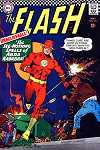 THE FLASH #170
THE FLASH #170
With a title like, “The See-Nothing Spells of Abra Kadabra,” it pretty easy to divine who the villain of the issues is, in this tale by Fox and the art team of Carmine Infantino and Sid Greene. Less evident however, unless you actually crack the cover, is that this story features some of Flash’s pals who, at this point, were still from Earth-2, including the original Flash, Jay Garrick, and the Doctors, Fate and Mid-Nite.
— on-sale Thursday, March —
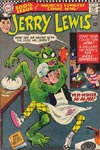 THE ADVENTURES OF JERRY LEWIS #100
THE ADVENTURES OF JERRY LEWIS #100
Marvel may have had “The World’s Greatest Comics Magazine” in the Fantastic Four, but in Jerry Lewis, DC had, as it humble declares on this centennial outing, “Americas’ Funniest Comic Mag!” Jerry started out adventuring alongside his old partner Dean Martin, with #1 of this series landing on stands May 21, 1952. Poor Dino got the boot when the duo broke up in real life, however, and this became a Jerry solo title with #41 (Sept. 17, 1957). This issue’s tale, “A-Haunting We Will Go” is by Drake and DC’s go-to humor artist of the period, Bob Oksner. Interestingly, #s 101-104 would feature art by a young Neal Adams. And, while 100 issues is impressive, especially by today’s standards, Jerry’s title would soon be as dead as his movie career, ending at #124 (March 4, 1971). Oh, the ignonimity, out-lived by the romance line!
 BLACKHAWK #232
BLACKHAWK #232
Like Tomahawk, the Blackhawk team didn’t seem to know what to do with itself during the 1960s. You’d think they would have become Cold War operatives, and in a way they did, battling the International Crime Combine, but two issues before this outing, DC took one of the most ill-advised turns of all time, turning the Blackhawks into D-List super-heroes, with codenames like The Leaper, Dr. Hands, M’Sieu Machine, and The Listener — the latter featuring Chuck in a costume that was, I kid you not, a suit of purple pajamas with pictures of ears all over it. Anyway, “With These Rings I Thee Kill,” was written by Bob Haney and drawn by Dick Dillin and Charles Cuidera. The mag would make a brief return to classic form with #242, too late to save the book from cancellation at #243 (Aug. 15, 1968). It would be revived for a brief seven-issue run in 1976, then return at #251 (July 1, 1982) for a 23-issue reprise by Mark Evanier and Dan Spiegle that remains, to this day, one of my personal favorite comic book series of all time.
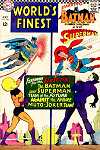 WORLD’S FINEST COMICS #166
WORLD’S FINEST COMICS #166
Sometimes, DC would set a story in the 30th century, either forgetting, or simply not caring about the Legion of Super-Heroes. That was generally okay, because, back in the day, what mattered as internal story continuity, not cross-company continuity of every comic DC published, ever. Still, this story, “The Danger of the Deadly Duo” by Jim Shooter — who, c’mon, HAD to know the ramifications of setting this story in the Legion’s time — and drawn by Curt Swan and George Klein, is kind of a stinker. In it, the Superman of 2967 (Klar Ken T5477, a fellow never mentioned in any Legion story) meets Bron Wayn E7705, who, shades of The Phantom, is the 20th direct descendant of Bruce Wayne to declare, “I know, I shall become a bat, for criminals, even in the 30th century, are a cowardly and superstitious lot!” The two team up against the 30th century descendant of The Joker and the mutant enemy of future Superman, named, appropriately enough, Muto. You might ask why Muto instead of Lex Luthor. After all, we’ve got direct descendants of Superman, Batman, and The Joker, why is Lex the only one not to successfully reproduce? Truth is, while this is the first (and, to date) only appearance of Bron Wayn, Klar Ken had appeared three times before, usually with Muto as his arch-enemy. To my knowledge though, neither he, nor, Klar, nor Bron, nor even Joker 2967 ever appeared again after this issue. Still, if Maniak Flip Fogler can turn up after 50 years, don’t count any of these dudes out!
— on-sale Tuesday, March 14 —
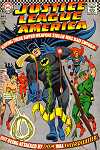 JUSTICE LEAGUE OF AMERICA #53
JUSTICE LEAGUE OF AMERICA #53
The gadgets and accoutrements —and, in Hawkman’s case, a “special coin” — of the non-powered Leaguers work against them in, “Secret Behind the Stolen Super-Weapons,” a tale no up to the usual snuff of Fox and Sekowsky. Altough, if I’m being honest, I never much warmed to Sekowsky on JLA and think his style worked much better on The Maniaks. This issue also guest-stars Hawkgirl, with some of the Leaguers learning her secret identity for the first time, not that it should have been all that hard to figure out if they knew who Hawkman was.
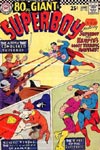 SUPERBOY #138
SUPERBOY #138
It’s an 80-page giant of Superboy reprints at 25¢ (that’s $1.82 in 2017 dollars). The stories are nominally chosen for fitting the theme of “Superboy and Krypto’s Most Terrific Battles!” but I don’t recall Super-Dog featuring over much in the first appearance of Dev-Em. Ya know, I think that first Dev-Em story has been reprinted about a dozen times over the years, which is a least five more times than he’s appeared since. This issue also reprints “Krpyto’s Arch-Enemy” from Superboy #92, which features the only appearance of Lex Luthor’s dog Destructo, and “The Secret of the Flying Horse,” from Adventure Comics #230, featuring a Super-Horse who is not Comet.
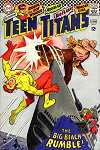 TEEN TITANS #9
TEEN TITANS #9
“The Big Beach Rumble” is written by Haney, drawn by Irv Novick, and inked by Cardy, and features the Titans preventing a spring break rumble of two rival colleges by get them to challenge each other in the construction of a jetty to protect the sand of Baxter Beach. How green of them! Although, I think the DEP frowns on jetties these days. Anyway, the good deed backfires when a passing pirate, Captain Tiger, runs his submarine aground on the uncharted ocean obstruction, causing all manner of malicious mayhem!
— on-sale Thursday, March 16 —
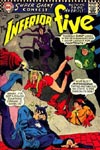 THE INFERIOR FIVE #2
THE INFERIOR FIVE #2
Unlike the Maniaks, Bridwell’s other comedic creations sold well enough to warrant their own mag, albeit lasting a mere 10 issues — #s 11 and 12 would come along in 1972 with reprints of their initial Showcase outings. This sophomore story, “The House-Hunting Heroes,” by Bridwell and Sekowsky, has the I5 searching for a new HQ. It cameos just about everyone at DC, including the Justice League, the Doom Patrol, the Challengers of the Unknown, the Sea Devils, the Blackhawks, and the Legion of Super-Heroes. If you’re a LSH uber-geek like me, this issue is notable for a panel in which Invisible Kid sings the Legion theme song. No, seriously! The story also features a Fantastic Four parody, The Kookie Quartet, who would appear again in #10.
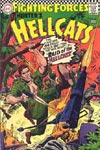 OUR FIGHTING FORCES #107
OUR FIGHTING FORCES #107
Just as Our Army at War was, in everything but the indicia title, a Sgt. Rock book, so, too, did Our Fighting Forces try to ply its masthead off on a lead series. Unlike Our Army, that took a couple of tries in Our FF. The title made its debut Aug. 18, 1954, and many early issues from #45 (March 10, 1959) featured Gunner & Sarge — later joined by dog-pal Pooch — but they never “owned” the title in the sense of supplanting the cover logo with their own names. The first attempt to do that was with The Fighting Devil-Dog, who just happened to be Sgt. Rock’s brother, who served in the Marines. After making his debut in #97, his name appeared over the Our FF logo starting with #97 (Sept. 23, 1965). He only lasted there three issues, however. Then, starting with #102, the Our FF logo got reduced and shifted up to make room for Capt. Hunter, a kind of discount Nick Fury. But after four issues, the logo changed to feature his version of the Howlin’ Commandoes, in Lt. Hunter’s Hellcats. This is the second issue of that logo, which came in a couple of different versions. With #123 (Nov. 11, 1969) the title was taken over by The Losers, a team that included Gunner & Sarge, as well as aviator Johnny Cloud and Navy man Capt. Storm. Strangely, at about the time in 1977 when Our Army officially changed its title to Sgt. Rock, and Star-Spangled War Stories gave way to The Unknown Soldier, Our FF, instead of giving way to The Losers, actually re-assumed control of the masthead. The book would only last four issues after that, however, ending its run at #181 on June 8, 1978.
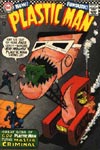 PLASTIC MAN #4
PLASTIC MAN #4
When DC purchased Quality Comics in 1957, it continued some of that company’s titles, including Blackhawk and G.I. Combat, but for reasons I’ve never understood, it discontinued Plastic Man. It’s not like there was a conflict with the Elongated Man. He wouldn’t twitch his mystery-loving nose for the first time until 1960. And Plas was one of the few super-heroes to survive the Golden Age! But by the time Quality folded, Plas’ comic had been quietly serving up reprints for a couple of years. The conventional wisdom is that DC didn’t see enough sales potential in a book that apparently didn’t move enough copies each month to finance new material. So, into the can it went. Then, a decade later, publisher Myron Fass put out four issues of Captain Marvel, hoping to take advantage of any lingering name recognition from the character that once outsold Superman, which Fawcett stopped publishing in 1953 rather than continue fighting a copyright infringement lawsuit filed by DC that I think most today can recognized as spurious, at best, the real intent being to knock out the competition for the dime of young comics fans. This new Captain Marvel bore no resemblance to the original beyond the name. He was actually an android with the basic powers of Substitute Legionnaire Arm-Fall-Off-Boy, who activated his appendage disassociate by shouting, “SPLIT!” Anyway, in the first issue, Capt. Marvel fights a guy from Venus named Gronk, who, due to his plyable powerset, goes by the name Plastic-Man. Well! DC would have none of that. It apparently sent Fass a cease-and-desist letter, because in Captain Marvel #2 Plastic-Man becomes Elastic Man. But, just to make sure it secured its copyright, in House of Mystery #160 (on-sale May 1, 1966) DC had Robby Reed use his H Dial to change into Plastic Man. Then to make sure it also had the trademark wrapped up, DC issued a new Plastic Man series, with the first issue hitting stands Sept. 22, 1966. The series only lasted 10 issues, all written by Drake, with art in this outing by Win Mortimer. Issue #7 would reveal that the Plastic Man in this series was the son of the original. However, when DC made a second short-lived revival run in 1975, it was back to original Plas, with no mention of a son. Much later, as part of the Kingdom Come event, a new Plastic Man son would be introduced, going by the appropriate-enough code name, Offspring.
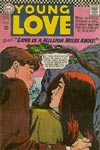 YOUNG LOVE #61
YOUNG LOVE #61
While most of the DC romance comics had an air of elegance to them, YL always looked to me like it fell of the truck coming from the Charlton printing press. Maybe that’s because this title actually started out at Prize Publications, purchased by DC in 1963 along with the industry’s first love comic, Young Romance. Starting at #39, Young Love didn’t get old until #126, out on April 19, 1977. In addition to the usual mush ‘n’ gush fodder of Jay Scott Pike, this issue also features art from John Forte, Ric Estrada, and Gene Colan. The Forte story is actually a reprint of a 1957 tale, redrawn with updated hairstyles. The Colan story, “First Prize — Heartbreak,” features his depictions of Frank Sinatra, Ava Gardner, and Bob Hope.
— on-sale Tuesday, March 28 —
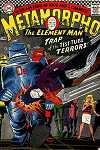 METAMORPHO #12
METAMORPHO #12
“The Trap of the Test-Tube Terrors” is the first of a two-part tale, written by Haney, who scripted at least 17 issues of this series, and drawn in this effort by Sal Trapani and Charles Paris. When I was a kid in the 1970s, Metamorpho was strictly a C-List hero, who’d occasionally pop up in The Brave and the Bold and such. His 1960s series predated me, as did his famous refusal to join the JLA in #42 of their mag (on-sale Dec. 9, 1965, concurrent with #4 of his series, in an early form of DC cross promoting in an attempt to goose sales. But for me, Metamorpho would not matter until 1983, when he joined Batman and the Outsiders.
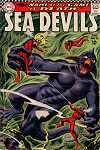 THE SEA DEVILS #35
THE SEA DEVILS #35
A group of underwater adventurers modeled after the Fantastic Four, by way of the Challengers of the Unknown, the Sea Devils were successful in ways The Maniaks were not. First off, they graduated from their Showcase try-out (#s 27-29, on sale May 26, July 28, and Sept. 27, 1960) into a series of their very own. The first issue of that book went on sale July 11, 1961, but with this number, the tide went out. The Devils — leader Dane Dorrance, muscle Biff Bailey, lady parts Judy Walton, and her kid brother Nicky — would not resurface until the free swim that was Showcase #100. Yes, the same jam issue for which The Maniaks were deemed too trivial to appear.
— on-sale Thursday, March 30 —
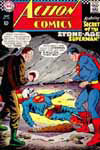 ACTION COMICS #350
ACTION COMICS #350
While spelunking in France, Perry White discovers an ancient skeleton wearing a Superman costume. Curious enough to investigate, Superman travels back in time to the days of dinosaurs and cavemen (science Flub No. 1, Unca Mort!). However, Superman soon discovers Earth has a red sun at this point in its history (Science Flub No. 2!) and he has no powers. He battles a cave man who wants his super-suit and is rescue by one of his Super Deus Ex Robots, which leaves its own costume behind, thus solving the riddle. “The Secret of the Stone-Age Superman” was by Otto Binder and Wayne Boring. The Supergirl back-up tale in this issue, by Dorfman and Jim Mooney, guest-stars Batman, Green Lantern, Green Arrow and Hawkman, who help apprehend a criminal rock band (a sort of Anti-Maniaks, if you will) who commit crimes dressed as the heroes.
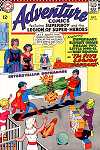 ADVENTURE COMICS #356
ADVENTURE COMICS #356
Bridwell fills in for Shooter, who is apparently busy elsewhere in the 30th century, on “The Five Legion Orphans,” which features rare appearances of several Legion parents. The story, drawn by Swan and Klein, has those team members without parents of their own kidnapped and turned into babies to be adopted by residents of the planet Baskh who have lost their own children. This issue includes the first mention of Rokyn, also known as New Krypton, the planet on which the Bottle City of Kandor would eventually be enlarged. But in a goof, Brainiac 5’s home planet Colu is named Yod. So much for Bridwell being the DC trivia expert.
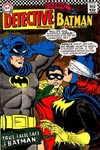 DETECTIVE COMICS #363
DETECTIVE COMICS #363
In “The True-False Face of Batman,” by Fox, Infantino and Greene, the caped crusader pulls a double-switch on Batgirl, revealing himself to be Bruce Wayne, but in the capture of a crook convincing her that he was only disguised as Wayne as part of the crime-solving operation. The same creative team then contributes an Elongated Man back-up in which criminals use UHF transmissions to make people act out their impulses and commit crimes for them. Ah, so that’s what all those extra channels where on the tv dial when I was a kid!
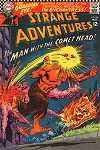 STRANGE ADVENTURES #200
STRANGE ADVENTURES #200
And finally, acting counter to other long-running DC anthologies of the era that seemed desperate to kind a regular feature, Strange Adventures seemed intent on skirting every such opportunity. Even when it did feature a recurring character, like Animal Man, the Immortal Man, or Enchantress, it did so only sporadically. This issue does have an Enchantress story by Haney and artist Howard Purcell, but for its big bicentennial issue, the adventure gets truly strange, as editor Jack Schiff chooses to cover-feature “The Man with the Comet Head,” by Binder and Sparling. I’ve not had a chance to read the story, but, man, that is one weirdsville cat on the cover. How Comet Head never became a member of the Grant Morrison Doom Patrol is beyond me!
Well, it’s the end of another trip to DC days of yore, Bubblenauts. Next week is a fifth week, so Time Bubbles will be down for some much-needed recalibration of its flux capacitor. Come back April 7th (or thereabouts) when we’ll time skip to the first week of April 1977, for the real secret origin of the Justice League of America.
Until then, remember, “Hey, Kids! COMICS!”
